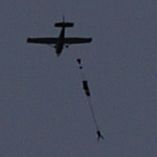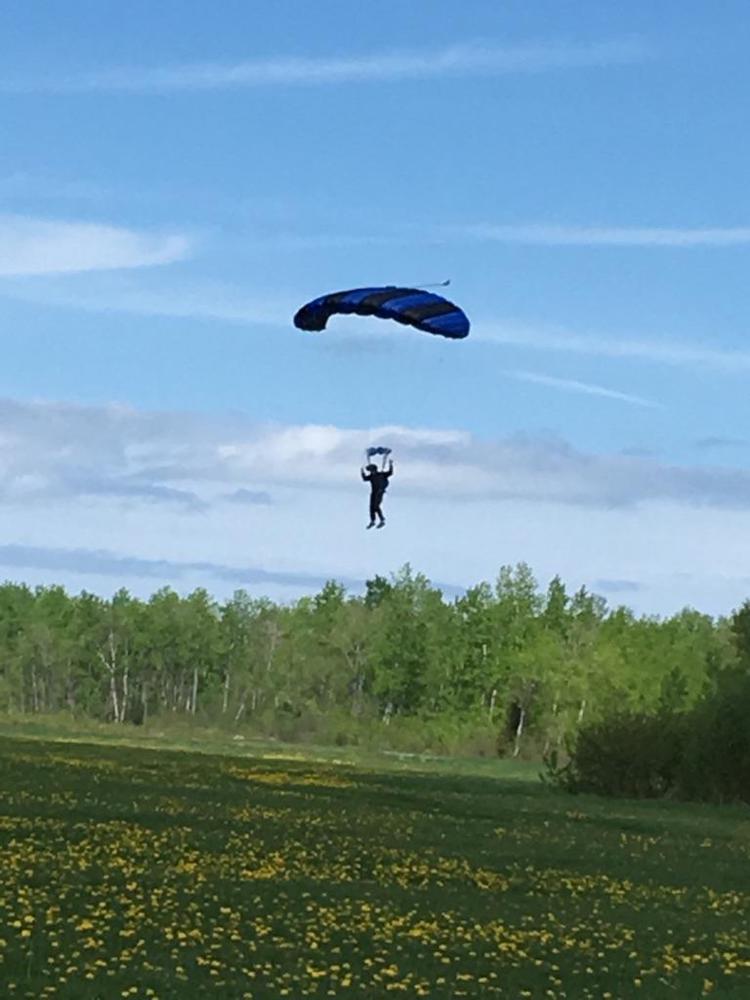Recommended Posts
RIGGER 0
I never heard about that.
Have an AAD but keep the loop out of the cutter to eliminate mis-fire issues sounds like "no AAD" at all.
Where you got that info. ?
Safe Jumps !!!
RIGGER 0
Well, I do agree with you about a lot of the points you came up with.
Regarding the WET reserve that was used & ended with a tragic end - all you said is fine: wing load, m.g.w, alti.,temp. BUT the reserve was WET & we do not have any data about WET reserves deployments, the issue came up in the last PIA meeting in Reno & I hope a study will start, maybe it was a rigging error ? who knows ????
Maybe if one factor in that tragic event would be eliminated like the reserve was DRY & the person could be saved.
By opening the 20 years subject here I can read other riggers / non riggers opinions.
PD, Aerodye, PDF, Parachutes Systems S.A (chute shop) did not put the I&R / deployments limits for sales reasons - no way t.m.o !!! there is a technical reason for that, they might have less sales because of the limits ? when other mfg. do not have ANY limit, I would go with the limited reserves & not with the FREE spec. reserves. I do not thing that PD or Aerodnye have a lower sales rate for that reason.
What would you say about not marking the PD boxes "saving" the owner / next owner $$$ ? not keeping the history of non marked reserve like Smart, PDF.
More h/c mfg. are asking to return h/c to the mfg. for major repairs ? why ? there are reasons for that !!!
There are more factors that might effect the reserve fabric even new or 10,15, 20 years old but we all know that the "Porosity" does go higher with handling, repacks, surface it was packed, water jumps, washing & handling after being wet & more.
I do not see any connection between airplanes & reserve parachutes or h/c - the only in common is that they both TSO'd items & Airborne !!!
Safe Skydiving !!!
PhreeZone 14
The Service Bulletin was 01a. http://www.parachutemanuals.com/index.php?option=com_remository&Itemid=0&func=startdown&id=235 It said if the rig was to be used in static line operations and was made prior to March 2004 then the proper routing was for the reserve loop not to pass through the cutter. Might as well have removed it.![]()
And tomorrow is a mystery
Parachutemanuals.com
riggerrob 558
That is a delicate political question.
Hee!
Hee!
Many younger Canadian riggers refuse to repack gear more than 20 years old because:
1. 20 years marks the end of the "acid mesh era" for round reserves.
You may call me an arrogant, opinionated, grumpy, old, master rigger, but I see no point to wasting time on round reserves from the the acid mesh era. I also tell young riggers not to waste dollars on tools to test for acid meah, because round reserves fell out of fashion at most Canadian DZs a decade ago.
2. Furthermore, 20-years-ago the industry was starting to learn the limits of light weight round reserves built under the low speed category of TSO C23B.
In conclusion, only stupid fat men jump low speed reserves.
3. Cypres was only introduced 16 years ago, so many 20-year-old containers lack Cypres pockets. Sewing in Cypres pockets is above the license for Canadian Rigger As.
4. Fashon. Most 20-year-old containers are not "freefly friendly!"
gasp!
shock!
horror!
outrage!
ROFLMAO!
5. ZP fabric was only introduced 18 years ago, so 20-year-old mains are made of "substandard material!"
gasp!
shock!
horror !
outrage!
6. 5-cell Swifts were the most popular square reserves 20 years ago, and they have those "funky" brake lines - that I even I have to consult the manual about - that are too complicated for young riggers.
scratching head in confusion????
7. Ravens were the most second most popular reserves 20-years-ago. Ravens have fallen out of fashion because of that horrible 'turning" problem and the fact that they flare like bag-locks when you load them at 2 to 1!
Tee!
Hee!
In conclusion, you may call me a grumpy, old, gray-bearded Master rigger, but few customers ask me to repack 20-year-old gear anymore and I see little point to young riggers wasting their time and dollars learning how to pack ancient equipment, when much better (i.e. reserves that can be loaded more than 1 pound per square foot) is readily available.
Besides, I enjoy trading ideas with Shlomo.
On this issue, I have to back Shlomo, but for slightly different, vaguer reasons.
Shlomo is half the fun of dz.com!
Tee!
Hee!
CReWGEEK 1
RIGGER 0
Thanks for the post.
Years ago PIA had a TS-112 " Equipment service life"
As much as I understand from the PIA meetings I was that the PIA & mfg. that are for a life service
limit and 20 years was the area of the top limit. One mfg. went down to 10 years.
PD is giving a shelf service life of 2 years from date of buying threads, Fabric, lines for doing repairs on PD reserves & all materials must be from PD. (PR manual page 27 & please also read PD manual Section 4 page 22 - 27.
Well, maybe saying PIA RECOMMENDATION was not an accurate saying but it was based on what I heard at the meetings.
I know other riggers that think & work the same way,
there are many parameters to be considered when a 20 years old system arrives to a rigger for re-certification & repack.
All,please read the FAA H-8083-17 PARACHUTE RIGGER HAND BOOK page 1-9 "PARACHUTE SERVICE LIFE"which starts with "There is no service life on the parachutes, it may be considered airworthy as long as it meets its TSO." please read all the way down.
From the book as been copied: (I bolt the 4 last lines)
PARACHUTE SERVICE LIFE
There is no service life on the parachute; it may be considered
airworthy as long as it meets its technical standard
order. While the parachute appears to be in good
condition, there are not many non-destructive tests
available to the parachute rigger in the field to make
this determination. It may be possible to drop test the
parachute, but the cost would probably outweigh the
value of the system. It is up to the parachute rigger to
make the determination as to the airworthiness of the
parachute system. When the parachute rigger seals the
parachute and signs the data card, the rigger is saying it is
ready, thereby putting the customer’s life on the line.
What should the parachute rigger do? This is not just a
theoretical situation—it is one that has been experienced
many times by many parachute riggers. All of the above
information plus economic factors complicate the parachute
rigger’s decision. If the rigger does not pack the
parachute, the pilot may take it down the road to another
parachute rigger for a second opinion who may not have
the same standards. An added factor is liability exposure.
If the parachute rigger signs off on a questionable parachute
and an accident occurs later, the rigger may be
exposed to disciplinary action from the Administrator in
addition to civil action in the courts. There are no hard and
fast rules in these situations, but instead, the parachute rigger
must exercise the best judgment the rigger can summon
based on experience and the information at hand.
Most professional parachute riggers would refuse to pack
the parachute described in the scenario above, due to a
combination of age, the size of the individual, and the
potential use parameters.
It is about time that the PIA will take a position on that point. It should be a "PRO" call based on R&D & civilian & military data.
I hope all was good at the PIA meeting last week.
Safe Rigging !!!
hackish 8
QuoteQuoteOn the topic of old equipment an older fellow brough his old gear by the DZ, He had over 1000 jumps back in the 1960's and had a really nice paracommander style round. One of the guys at the DZ wants to jump it.
So it might have looked like one of the rigs in the attached photos.
Yes it looked like the big green one second to the end. I looked at their "release" system and there is no way I'd consider jumping it either. The reserve procedure consisted of unzipping the belly mounted reserve and throwing it out to the wind. YIKES!
Quote
As many others have said a well taken care of older rig can be used and still be safe. The trick is finding old stuff in good airworthy shape, there is lots of old junk around and but there is some real sweet finds around as well too.
I think this one falls into the sweet find category. Although the owner hadn't jumped for 20 years he did take good care of the equipment airing and repacking it every couple of years. The guy who wants to jump it is known as "crazy larry". Although the nickname is funny with his experience I don't think he'd jump something unsafe.
Certainly the riggers inspecting it have a reputation for being extra cautious. I'm hoping he can do the jump and I can get photos because it's a really cool looking PC chute. I won't spoil it too much because I'm sure he'll try to get it published.
-Michael
RIGGER 0
The reasons you posted are all true & well said.
Every rigger has his own opinion & freedom to think.
I would say: riggers think twice when you in touch with an old system h/c & reserves without history.
Safe Rigging !!!
Thousands of jumps are probably made without an AAD but if YOU are asked to pack a reserve with an AAD then surely as A paying customer THE LOOP SHOULD GO THROUGH THE CUTTER.
Hell what do i know i just pay riggers to reserve pack and to hell with the consequences.
With all this EGO bullshit its a bit pot and kettle.
I for one vote for RIGGER for bringing this to jumpers attention cos without us jumping there would be no rigging work. ![]()
I still jump it (at least twice a month), the fabric is still OK, it lands me nicely and it does not blow up on opening.
And I am talking about a PC that is 41 years old and that it had been jumped hard a lot!!!
You need some good electroshocks to convince me that a round or square reserve built from synthetic fibers, with a few jumps, with very little UV expose is not airworthy because it's 20+ years old!
I am very glad I am a master rigger so as a costumer I don't have to deal with individuals like yourself.
To all:
Please mail me (I pay for postage) all the skydiving equipment that you consider un-airworthy solely based on age. As compensation I will mail you a framed pic on me jumping the piss out the equipment. Please PM if interested so I can send you my address.
The bigger problem is that Shlomo is mis-representing the truth by saying that packing a 20+ year old piece of equipment goes against a PIA recomendation. Not true.
You're not as good as you think you are. Seriously.
RIGGER 0
First I do not have to convince you !!! you are a big boy without name & details & as a Master Rigger you can do what ever is the best for you & your customers.
It is sad to see how riggers & skydivers goes personal like you said "individuals like yourself"
You do not know me as I do not know you so be PRO , fill your profile & keep the subject at a high level, we all might learn from each other.
Enjoy your P.C !!!
Be Safe & have a name !!!
RIGGER 0
Please read my post to Terry, that is what I understand from the PIA meetings when I was there.
There are lofts in the USA that are not working with 20 years old systems - it is a policy based on
something.
Be Safe !!!
councilman24 36
The meeting went well.
TS-112 was quickly rescinded years ago shortly after adoption. If you have a copy of it you should note that it is no longer a PIA technical standard. PIA as an organization does not have any service life recommendation for any gear. Many individuals who happen to be members have opinions, including you and I. This weekend we discussed a service life recommendation specifically for orphaned equipment in Technical Committee. A draft document was rejected by vote. The majority of opinions voiced in the committee was for PIA to take NO position on service life. Some members didn't voice an opinion. But NO vote was taken in supprot of any specific service life and PIA still has NO recommendation on service life.
The FAA manual was written by one author who happens to be a proponent of a specified service life. As it states there is no service life imposed by the FAA. As always, individual riggers make their own determinations of airworthiness.
One major reason manufacturers would like to impose a service life is to limit liability. Another is to keep gear not designed for current skydiving practices (i.e. head down) from being used inappropriately. The other obvious reason is because it's impractical or impossible to fully test the strength any individual system for airworthiness determination.
One other way manufacturers have and are using to limit liability is to sell the assets of one company to another and dissolve the original company. Relative Workshop to UPT is one case. Glide Path to Flight Concepts is another situation. And Precision Aerodynamics to Precision.aero is a third. There are good and approriate business reasons for these changes that may or may not include limiting liability. But one conseqence is that all Glide Path, Precision Aerodynamics, and Uninsured Relative Workshop products are "orphan" equipment. Subsequent companies choose to support the previous companies products to varying levels.
No matter what might be discussed in PIA committee or plenary meetings, unless formal action is taken PIA as an organization has no opinion. It doesn't matter what my opinion or any other committee chairman's or individual member's opinion may be. Even a consensus in a committee doesn't mean that PIA has a position unless it is formally adopted. PIA may choose not to take a position.
Please DON'T quote something as a PIA position unless there is a current written document available that supports it.
Terry Urban
D-8631
FAA DPRE
jumper03 0
Thanks for the clarification Terry. I appreciated the lesson. ![]()
RIGGER 0
Thanks for that.
I understand the points.
Be Safe !!!
Maybe I shouldn't even be posting in this forum, and maybe I should know this already, despite being a noob, but could someone please post a pic of what it's SUPPOSED to look like? Just for my own information.
Thanks,
Skydude
Quotedespite being a noob, but could someone please post a pic of what it's SUPPOSED to look like?
Use your imagination! A white loop going through a metallic cutter.
RiggerLee 61
Storie, the rigger I'd spoken to before is out of town so I can't get ahold of him for another week. Is any one fermilior with a report suggesting that nylon over 25 years old can experence sudden rappid detereration in strength bassed on age alone? I can't find it.
On a more practical note, would PD care to share what they have found with their monitoring program? I'm sure they're out there lissening. That's as good example of a study of modern canopies at there "mid life" as we have. Strong should also have some data by now with all the tandoms they've pulled into the shop. I concidder that in a whole nother cat. but it would still be interesting.
Lee







What do you mean "make sure it is safe" ???
Thanks.
Share this post
Link to post
Share on other sites